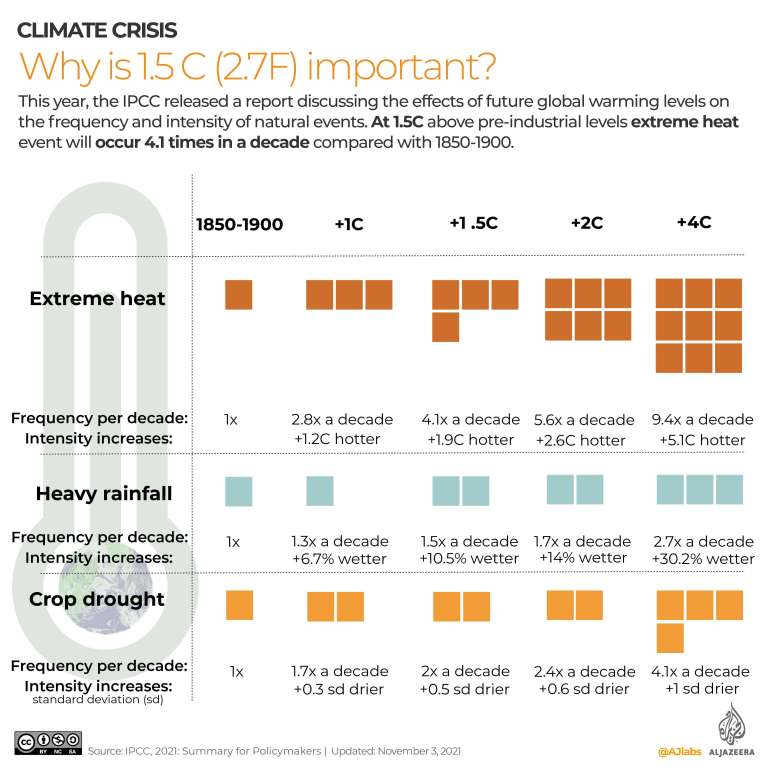Infographic: COP26 goals explained in maps and charts
The annual climate change summit is under way in Glasgow as nations try to reach an agreement to limit global warming.

The 26th United Nations Climate Change Conference of the Parties (COP26) began in Glasgow, Scotland, on October 31. World leaders, climate experts, campaigners and financiers will discuss the pressing issue of intensifying climate crisis till November 12.
This year’s conference will aim to reach a consensus on actions to keep global warming to 1.5 degrees Celsius (2.7 degrees Fahrenheit) above preindustrial levels and to secure net-zero emissions by 2050.
Keep reading
list of 4 itemsCOP26 climate summit opens in Glasgow amid acrimony
COP26: Developing nations urge rich ones to fund climate goals
COP26: Is carbon offsetting a stalling tactic?
It comes after the historic Paris Agreement in 2015, which set out long-term objectives to limit the global temperature rise to below 2C (3.6F) to prevent catastrophic damage caused by global warming.
More than 120 world leaders gathered during the first two days of COP26 to outline their climate change commitments.
British Prime Minister Boris Johnson said: “As this first stage of COP26 draws to a close – and don’t forget there are still two weeks of detailed negotiation to come – we must take care to guard against false hope and not to think in any way that the job is done because it’s not, there’s still a very long way to go.”
With world leaders leaving the summit, negotiators and cabinet ministers will be responsible for ironing out new deals to deliver on the goals set out for COP26.
What are the goals in Glasgow?
Following a year of devastating natural disasters, from heatwaves to raging wildfires and flooding, COP26 will be key to advancing new commitments to limit climate change.
The Paris Agreement will be re-examined at the summit with nations being asked to deliver more ambitious pledges on how they will reduce their greenhouse gas emissions, known as Nationally Determined Contributions (NDCs).

The United Kingdom has set out four goals to achieve during the conference. These include:
Global net zero and 1.5C: Nations are being called on to reach net-zero emissions by 2050 and to keep to the 1.5C warming limit. To reach these targets by 2030, countries will need to phase out coal, invest in renewable energy, curtail deforestation and switch to using electric vehicles.
At the summit, more than 100 world leaders agreed to end deforestation by 2030. The pledge includes mobilising 14 billion British pounds ($16bn) of public and private funds.
Protect communities and natural habitats: States are being encouraged to protect and restore ecosystems, as well as build defences, warning systems and resilient infrastructure to avoid the loss of lives, homes and livelihoods.
Mobilise finance: The Paris Agreement set a goal of providing finance to developing countries to tackle climate change. At this year’s summit, developed nations are being told to act on their promise to give at least $100bn in climate finance per year from 2020 to help secure global net-zero emissions. It is a funding target now likely to be reached by 2023.
Collaboration: At COP26, parties will need to finalise the Paris Rulebook, which sets out the steps needed to realise the Paris Agreement. Governments, businesses and civil society will need to work collaboratively to deliver these climate goals.

Why is 1.5C important?
This year, the Intergovernmental Panel on Climate Change (IPCC) released a damning report outlining the effects of potential climate futures on the frequency and intensity of natural events such as heatwaves, flooding and sea level rise.
In 2018, the IPCC published a special report on the importance of limiting global warming to 1.5C above preindustrial levels.
Currently, the world’s temperature has already risen to 1.1C (1.98F) above 1850-1900 levels. The 2021 IPCC report projects that at 1.5C the frequency of heatwaves every 10 years would increase 4.1 times compared with preindustrial levels.
The likelihood of heavy precipitation events would increase to 1.5 times every 10 years compared with 1850-1900. World food production would also be at risk, with the frequency of once-in-a-decade crop drought events in drying regions increasing to twice in a decade at 1.5C higher than preindustrial levels.

China: The largest emitter of carbon dioxide
China was responsible for releasing 10.17 billion tonnes of carbon dioxide in 2019, according to data from the Global Carbon Project. China alone accounted for 28 percent of global CO2 emissions last year.
China’s heavy reliance on coal contributes to its share of worldwide carbon dioxide emissions. More than 71 percent of its CO2 emission comes from burning coal. Last year, President Xi Jinping pledged to attain carbon neutrality in China by 2060.
Xi was absent from the COP26 summit, and instead released a written statement at the talks.
The next-highest emitter of CO2 is the United States, which released 5.28 billion tonnes of the gas in 2019.
India is the third-highest emitter of carbon dioxide, with 2.62 billion tonnes released last year.

Who has set net zero goals?
Net zero refers to the balance between greenhouse gases released and removed from the atmosphere.
Carbon neutrality is a state of net-zero CO2 emissions, while becoming climate neutral means reducing greenhouse gas emissions as much as possible and compensating for any remaining emissions.
In total, 137 countries have committed to net zero, carbon neutrality or being climate-neutral, according to the Energy and Climate Intelligence Unit.
India is one of the latest countries to pledge net zero, with Prime Minister Narendra Modi announcing at COP26 an aim to reach that goal by 2070.
